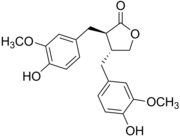Lignan
The lignans are a large group of low molecular weight polyphenols found in plants, particularly seeds, whole grains, and vegetables.[1] The name derives from the Latin word for "wood".[2] Lignans are precursors to phytoestrogens.[1][3] They may play a role as antifeedants in the defense of seeds and plants against herbivores.[4]
Biosynthesis and metabolism
[edit]-
Matairesinol, illustrating the dibenzylbutyrolactone motif
-
Secoisolariciresinol, illustrating the 9,9'-dihydroxydibenzylbutane motif
-
Justicidin A, illustrating the arylnaphthalene motif
-
Pinoresinol, illustrating the furanofuran motif
-
Steganacin, illustrating the dibenzocyclooctadienelactone motif
-
Podophyllotoxin, illustrating the aryltetralin motif
Lignans and lignin differ in their molecular weight, the former being small and soluble in water, the latter being high polymers that are undigestable. Both are polyphenolic substances derived by oxidative coupling of monolignols. Thus, most lignans feature a C18 cores, resulting from the dimerization of C9 precursors. The coupling of the lignols occurs at C8. Eight classes of lignans are: "furofuran, furan, dibenzylbutane, dibenzylbutyrolactone, aryltetralin, arylnaphthalene, dibenzocyclooctadiene, and dibenzylbutyrolactol."[5]
Many lignans are metabolized by mammalian gut microflora, producing so-called enterolignans.[6][7]
Food sources
[edit]Flax seeds and sesame seeds contain high levels of lignans.[1][8] The principal lignan precursor found in flaxseeds is secoisolariciresinol diglucoside.[1][8] Other foods containing lignans include cereals (rye, wheat, oat and barley), soybeans, tofu, cruciferous vegetables, such as broccoli and cabbage, and some fruits, particularly apricots and strawberries.[1] Lignans are not present in seed oil, and their contents in whole or ground seeds may vary according to geographic location, climate, and maturity of the seed crop, and the duration of seed storage.[1]
Secoisolariciresinol and matairesinol were the first plant lignans identified in foods.[1] Typically, lariciresinol and pinoresinol contribute about 75% to the total lignan intake, whereas secoisolariciresinol and matairesinol contribute only about 25%.[1]
Foods containing lignans:[1][9]
| Source | Lignan amount |
|---|---|
| Flaxseeds | 85.5 mg per oz (28.35 g) |
| Sesame seeds | 11.2 mg per oz |
| Brassica vegetables | 0.3-0.8 mg per half cup (125 ml) |
| Strawberries | 0.2 mg per half cup |
Prevalence and health effects
[edit]Lignans are the principal source of dietary phytoestrogens in typical Western diets, even though most research on phytoestrogen-rich diets has focused on soy isoflavones. Lignan's enterolignan products enterodiol and enterolactone have weak estrogenic activity, but they may also exert biological effects through non-estrogenic means.[1]
A 2021 review found that lignans have a positive effect on lipid profiles of patients with dyslipidemia related diseases.[10] As of 2022 there is limited evidence that dietary intake of lignans is associated with a reduced cancer and cardiovascular disease risk.[1]
See also
[edit]References
[edit]- ^ a b c d e f g h i j k "Lignans". Micronutrient Information Center, Linus Pauling Institute, Oregon State University. 2010. Retrieved 31 July 2017.
- ^ From lign- (Latin, "wood") + -an (chemical suffix).
- ^ Korkina, L; Kostyuk, V; De Luca, C; Pastore, S (2011). "Plant phenylpropanoids as emerging anti-inflammatory agents". Mini Reviews in Medicinal Chemistry. 11 (10): 823–35. doi:10.2174/138955711796575489. PMID 21762105.
- ^ Saleem, Muhammad; Kim, Hyoung Ja; Ali, Muhammad Shaiq; Lee, Yong Sup (2005). "An update on bioactive plant lignans". Natural Product Reports. 22 (6): 696–716. doi:10.1039/B514045P. PMID 16311631.
- ^ Umezawa, Toshiaki (2003). "Diversity in lignan biosynthesis". Phytochemistry Reviews. 2 (3): 371–90. doi:10.1023/B:PHYT.0000045487.02836.32. S2CID 6276953.
- ^ Adlercreutz, Herman (2007). "Lignans and Human Health". Critical Reviews in Clinical Laboratory Sciences. 44 (5–6): 483–525. doi:10.1080/10408360701612942. PMID 17943494. S2CID 31753060.
- ^ Heinonen, S; Nurmi, T; Liukkonen, K; Poutanen, K; Wähälä, K; Deyama, T; Nishibe, S; Adlercreutz, H (2001). "In vitro metabolism of plant lignans: New precursors of mammalian lignans enterolactone and enterodiol". Journal of Agricultural and Food Chemistry. 49 (7): 3178–86. doi:10.1021/jf010038a. PMID 11453749.
- ^ a b Landete, José (2012). "Plant and mammalian lignans: A review of source, intake, metabolism, intestinal bacteria and health". Food Research International. 46 (1): 410–24. doi:10.1016/j.foodres.2011.12.023.
- ^ Milder IE, Arts IC, van de Putte B, Venema DP, Hollman PC (2005). "Lignan contents of Dutch plant foods: a database including lariciresinol, pinoresinol, secoisolariciresinol and matairesinol". British Journal of Nutrition. 93 (3): 393–402. doi:10.1079/BJN20051371. PMID 15877880.
- ^ Yang, C., Xia, H., Wan, M. (2021). "Comparisons of the effects of different flaxseed products consumption on lipid profiles, inflammatory cytokines and anthropometric indices in patients with dyslipidemia related diseases: systematic review and a dose–response meta-analysis of randomized controlled trials". Nutrition & Metabolism. 18 (1): 91. doi:10.1186/s12986-021-00619-3. PMC 8504108. PMID 34635132.
{{cite journal}}: CS1 maint: multiple names: authors list (link)






